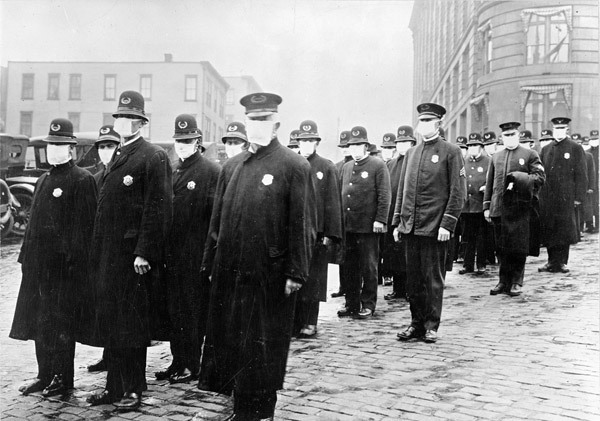The following is excerpted from the Bulletin of the North Carolina Board of Health concerning the spread of influenza. Guidelines like these were used to limit the influence and damages caused by illnesses like the flu, similar to safety guidelines today.
NOTE: this document is offered as a historical primary source about the 1918–19 influenza pandemic and should not be taken as health advice.
How and Where Influenza is Spread
- By careless spitting, coughing, sneezing, and using the same drinking vessel or towel others have used. The disease germs are carried in the spittle and in the little drops of secretion from the nose and throat.
- In crowds and public gatherings, churches, schools, picture shows, business houses, fairs, circuses, trains, or in any other places where people congregate. Soda fountains are especially dangerous if they do not supply individual sanitary cups and sterilized spoons.
How to Keep Away From Taking Influenza
- Keep away from crowds, especially indoor gatherings.
- Avoid people who cough, sneeze and spit without holding a handkerchief over the nose and mouth.
- Do not use common drinking cups or towels, and keep away from the soda fountain that does not supply individual cups and sterilized spoons.
- Keep the bowels open. Snuff Vaseline up the nose three times a day. Gargle mouth and throat and rinse out nose with warm salt water, using a level teaspoonful of salt to a glass of warm water. Sleep and eat regularly. These are very important.
- Keep in the open air and sunshine as much as practicable and have good ventilation in the home and office. Sleep with your windows open.
- Wash your hands before eating and never put your unwashed hands in your mouth.
- Do not give the disease to others—when you sneeze or cough always bow the head and cover both the nose and mouth with handkerchief.
Symptoms of Influenza and What to Do if You Take It
-
In most cases a person taken with influenza feels sick rather suddenly. He feels weak, has pains in the eyes, ears, head or back, and may be sore all over. Many patients feel dizzy, some vomit. Most of the patients complain of feeling chilly, and with this comes a fever in which the temperature rises to 100 degrees to 104 degrees. In most cases the pulse remains relatively slow.
In appearance one is struck by the fact that the patient looks sick. His eyes and the inner side of his eyelids may be slightly bloodshot or congested. There may be running from the nose, and there may be some cough. These signs of a cold may not be marked; nevertheless the patient looks and feels very sick.
- If you have any of the above symptoms, go to bed at once and send for a doctor and follow his directions explicitly.
- If you cannot obtain a doctor at once, stay in bed with plenty of cover to keep you warm, open all the windows and keep them open, take medicine to open the bowels freely, and take nourishing food, as milk, eggs, and broth, every four hours.
- Allow no one else to sleep in the same room. Protect others by sneezing and coughing into cloths which can be boiled or burned.
- Stay in bed until a doctor tells you it is safe to get up; or, until you have been without a fever for at least four days.
What To Do After Recovering From an Attack of Influenza
- Influenza is a treacherous disease. If one is fortunate enough to escape pneumonia during or immediately following the attack, the lungs and respiratory system are frequently so inflamed that tuberculosis develops. The heart is overworked and needs rest. Therefore, do not return to work or leave home until you have regained your strength, whether it is a week or a month.
- If complete recovery does not take place within two weeks, have your family physician carefully and thoroughly examine every vital organ and function of the body. Follow instructions the doctor may give you after such an examination.
